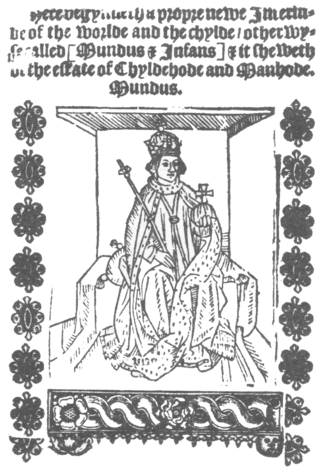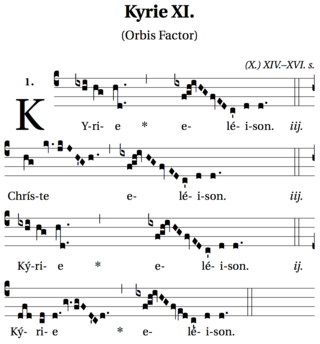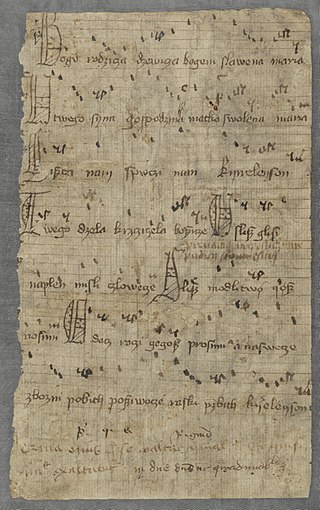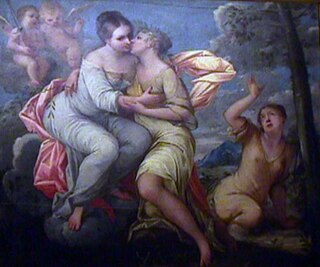
The Four Daughters of God are a personification of the virtues of Truth, Righteousness/Justice, Mercy, and Peace in medieval Catholic religious writing.

The Four Daughters of God are a personification of the virtues of Truth, Righteousness/Justice, Mercy, and Peace in medieval Catholic religious writing.
The most important contributors to the development and circulation of the motif were the twelfth-century monks Hugh of St Victor and Bernard of Clairvaux, [1] : 290 followed by the Meditations on the Life of Christ , which Bernard's text inspired. [2] : 90
The motif is rooted in Psalm 85:10, 'Mercy and Truth are met together; righteousness and peace have kissed each other'. The use in Christian thought seems to have been inspired an eleventh-century Jewish Midrash, in which Truth, Justice, Mercy and Peace were the four standards of the Throne of God. [3] [1] : 290
The motif was influential in European thought. In 1274–76, Magnus VI of Norway introduced the first "national" law-code for Norway, known now as Magnus Lagabøtes landslov . Chapter 4.18 of the code, which was key to introducing a new model of procedural law to Norway and was to be read out to judges, makes prominent use of the allegorical four daughters of God, Mercy, Truth, Justice, and Peace. They have the important role there of expressing the idea—which was innovative in the Norwegian legal system at the time—of equality before the law. [4]
The motif changed and developed in later medieval literature, but the usual form was a debate between the daughters (sometimes in the presence of God)
about the wisdom of creating humanity and about the propriety of strict justice or mercy for the fallen human race. Justice and Truth appear for the prosecution, representing the old Law, while Mercy speaks for the defense, and Peace presides over their reconciliation when Mercy prevails. [1] : 290
However, some versions (notably Robert Grosseteste's Chasteu d'amour, the Cursor Mundi , the English Gesta Romanorum , and The Court of Sapience)
develop it along the lines of a medieval romance. They place the story in a feudal setting and give to a great king four daughters, a son, and a faithless servant. Because of a misdemeanor the servant has been thrown into prison. The daughters beg for his release. The son offers to take upon himself the clothing of the servant and to suffer in his stead. Except for the element of the dispute and the method of reconciliation, the two main traditions in the development of the allegory are vastly different. [2] : 91
The motif fell out of fashion in the seventeenth century. [1] : 290 It may nonetheless have influenced the work of William Blake. [5]
In English and Scottish literature, the Four Daughters appear quite widely, for example in: [1] [2]
The Four Daughters also appear in visual depictions, particularly in Books of Hours, usually in the Annunciation section. [9] 'Justice is generally represented with scales or a sword; Peace with a palm, inverted torch, or truncated sword; Truth with a carpenter's square or tables of the Law; and Mercy with a box of ointment.' [1] : 290

Caterina di Jacopo di Benincasa, TOSD, known as Catherine of Siena, was an Italian Catholic mystic and pious laywoman who engaged in papal and Italian politics through extensive letter-writing and advocacy. Canonized in 1461, she is revered as a saint and as a Doctor of the Church due to her extensive theological authorship. She is also considered to have influenced Italian literature.

The morality play is a genre of medieval and early Tudor drama. The term is used by scholars of literary and dramatic history to refer to a genre of play texts from the fourteenth through sixteenth centuries that feature personified concepts alongside angels and demons, who are engaged in a struggle to persuade a protagonist who represents a generic human character toward either good or evil. The common story arc of these plays follows "the temptation, fall and redemption of the protagonist".

Robert Grosseteste, also known as Robert Greathead or Robert of Lincoln, was an English statesman, scholastic philosopher, theologian, scientist and Bishop of Lincoln. He was born of humble parents in Suffolk, but the association with the village of Stradbroke is a post-medieval tradition. Upon his death, he was revered as a saint in England, but attempts to procure a formal canonisation failed. A. C. Crombie called him "the real founder of the tradition of scientific thought in medieval Oxford, and in some ways, of the modern English intellectual tradition". As a theologian, however, he contributed to increasing hostility to Jews and Judaism, and spread the accusation that Jews had purposefully suppressed prophetic knowledge of the coming of Christ, through his translation of the Testaments of the Twelve Patriarchs.

Piers Plowman or Visio Willelmi de Petro Ploughman is a Middle English allegorical narrative poem by William Langland. It is written in un-rhymed, alliterative verse divided into sections called passus.

Wycliffe's Bible is a sequence of orthodox Middle English Bible translations from the Latin Vulgate which appeared over a period from approximately 1382 to 1395.

Kyrie, a transliteration of Greek Κύριε, vocative case of Κύριος (Kyrios), is a common name of an important prayer of Christian liturgy, also called the Kyrie eleison.

Paschasius Radbertus (785–865) was a Carolingian theologian and the abbot of Corbie, a monastery in Picardy founded in 657 or 660 by the queen regent Bathilde with a founding community of monks from Luxeuil Abbey. His most well-known and influential work is an exposition on the nature of the Eucharist written around 831, entitled De Corpore et Sanguine Domini. He was canonized in 1073 by Pope Gregory VII. His feast day is 26 April.

"Gloria in excelsis Deo" is a Christian hymn known also as the Greater Doxology and the Angelic Hymn/Hymn of the Angels. The name is often abbreviated to Gloria in Excelsis or simply Gloria.

Bogurodzica, in English known as the Mother of God, is a medieval Christian hymn composed sometime between the 10th and 13th centuries in Poland. It is believed to be the oldest religious hymn or patriotic anthem in the Polish language, which was traditionally sung in Old Polish with the Greek phrase Kyrie eleison – "Lord, have mercy". While its origin is not entirely clear, several scholars agree that Saint Adalbert of Prague is the likely author. Polish knights chanted Bogurodzica prior to their engagement at the Battle of Grunwald and it also accompanied the coronation ceremonies of the first Jagiellonian kings.

Henry Suso, OP was a German Dominican friar and the most popular vernacular writer of the fourteenth century. An important author in both Latin and Middle High German, he is also notable for defending Meister Eckhart's legacy after Eckhart was posthumously condemned for heresy in 1329. He died in Ulm on 25 January 1366, and was beatified by the Catholic Church in 1831.

Joseph and Asenath is a narrative that dates from between 200 BCE and 200 CE. It concerns the Hebrew patriarch Joseph and his marriage to Asenath, expanding the fleeting mentions of their relationship in the Book of Genesis. The text was translated widely, including into Amharic, Arabic, Armenian, Early Modern German, Latin, Middle English, Old French, Romanian, Serbian and Syriac.

The Orgelbüchlein BWV 599−644 is a set of 46 chorale preludes for organ — one of them is given in two versions — by Johann Sebastian Bach. All but three were written between 1708 and 1717 when Bach served as organist to the ducal court in Weimar; the remainder and a short two-bar fragment came no earlier than 1726, after the composer’s appointment as cantor at the Thomasschule in Leipzig.

Gulating was one of the four ancient popular assemblies or things of medieval Norway. Historically, it was the site of court and assembly for most of Western Norway, and assembled at Gulen. It functioned as a judicial and legislative body, resolving disputes and establishing laws.

The Castle of Perseverance is a c. 15th-century morality play and the earliest known full-length vernacular play in existence. Along with Mankind and Wisdom, The Castle of Perseverance is preserved in the Macro Manuscript that is now housed in the Folger Shakespeare Library in Washington, D.C. The Castle of Perseverance contains nearly all of the themes found in other morality plays, but it is especially important because a stage drawing is included, which may suggest theatre in the round.

Law in Norway follows a civil law system. The Supreme Court is the highest in the nation, with 20 justices.
The Brome play of Abraham and Isaac is a fifteenth-century play of unknown authorship, written in an East Anglian dialect of Middle English, which dramatises the story of the Akedah, the binding of Isaac.

Psalm 85 is the 85th psalm of the Book of Psalms, one of a series of psalms attributed to the sons of Korah. In the English of the King James Version, this psalm begins: "LORD, thou hast been favourable unto thy land". In the slightly different numbering system used in the Greek Septuagint and Latin Vulgate translations of the Bible, this psalm is Psalm 84. In Latin, it is known as "Benedixisti Domine terram tuam". In Judaism, it is called "a psalm of returned exiles". The Jerusalem Bible describes it as a "prayer for peace".
The Erl of Toulouse is a Middle English chivalric romance centered on an innocent persecuted wife. It claims to be a translation of a French lai, but the original lai is lost. It is thought to date from the late 14th century, and survives in four manuscripts of the 15th and 16th centuries. The Erl of Toulouse is written in a north-east Midlands dialect of Middle English.

European science in the Middle Ages comprised the study of nature, mathematics and natural philosophy in medieval Europe. Following the fall of the Western Roman Empire and the decline in knowledge of Greek, Christian Western Europe was cut off from an important source of ancient learning. Although a range of Christian clerics and scholars from Isidore and Bede to Jean Buridan and Nicole Oresme maintained the spirit of rational inquiry, Western Europe would see a period of scientific decline during the Early Middle Ages. However, by the time of the High Middle Ages, the region had rallied and was on its way to once more taking the lead in scientific discovery. Scholarship and scientific discoveries of the Late Middle Ages laid the groundwork for the Scientific Revolution of the Early Modern Period.

John 1:17 is the seventeenth verse in the first chapter of the Gospel of John in the New Testament of the Christian Bible.